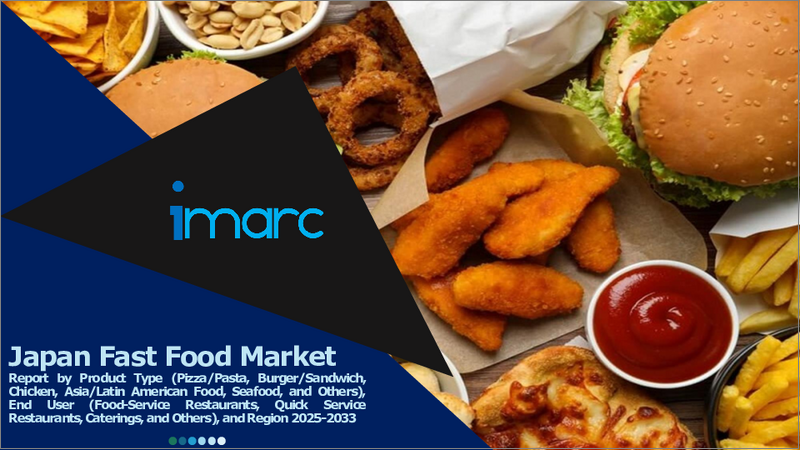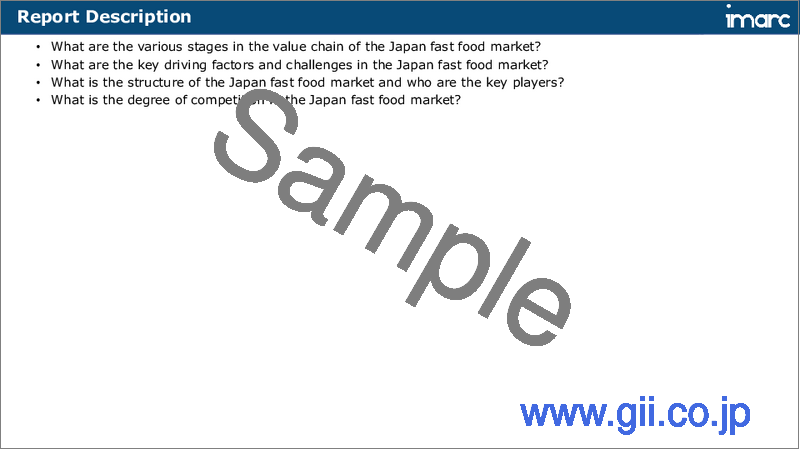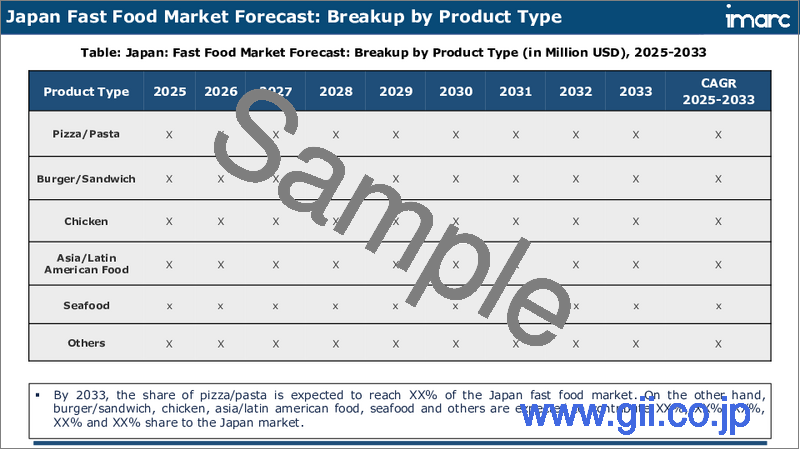|
|
市場調査レポート
商品コード
1729495
日本のファーストフード市場レポート:製品タイプ、エンドユーザー、地域別、2025年~2033年Japan Fast Food Market Report by Product Type (Pizza/Pasta, Burger/Sandwich, Chicken, Asia/Latin American Food, Seafood, and Others), End User (Food-Service Restaurants, Quick Service Restaurants, Caterings, and Others), and Region 2025-2033 |
||||||
カスタマイズ可能
|
|||||||
| 日本のファーストフード市場レポート:製品タイプ、エンドユーザー、地域別、2025年~2033年 |
|
出版日: 2025年05月01日
発行: IMARC
ページ情報: 英文 120 Pages
納期: 5~7営業日
|
全表示
- 概要
- 目次
日本のファーストフードの市場規模は2024年に586億米ドルに達しました。IMARC Groupは、2025年から2033年にかけての成長率(CAGR)は6.2%で、2033年には1,041億米ドルに達すると予測しています。急速な都市化とペースの速いライフスタイルの採用、革新的な料理フュージョンの導入、最近の技術の進歩、日本政府による有利な規制の賦課、ファーストフードチェーンと地元業者との協力関係の拡大は、市場を牽引する主な要因のいくつかです。
本レポートで扱う主な質問
- 日本のファーストフード市場はこれまでどのように推移してきたか?
- COVID-19が日本のファーストフード市場に与えた影響は?
- 日本のファーストフード市場の製品タイプ別区分は?
- 日本のファーストフード市場のエンドユーザー別の区分は?
- 日本のファーストフード市場のバリューチェーンにおける様々なステージとは?
- 日本のファーストフード市場の主な促進要因と課題は何か?
- 日本のファーストフード市場の構造と主要プレーヤーは?
- 日本のファーストフード市場における競合の程度は?
目次
第1章 序文
第2章 調査範囲と調査手法
- 調査の目的
- ステークホルダー
- データソース
- 市場推定
- 調査手法
第3章 エグゼクティブサマリー
第4章 日本のファーストフード市場:イントロダクション
- 概要
- 市場力学
- 業界動向
- 競合情報
第5章 日本のファーストフード市場情勢
- 過去および現在の市場動向(2019~2024年)
- 市場予測(2025~2033年)
第6章 日本のファーストフード市場:製品タイプ別の内訳
- ピザ/パスタ
- ハンバーガー/サンドイッチ
- チキン
- アジア/ラテンアメリカ料理
- シーフード
- その他
第7章 日本のファーストフード市場:エンドユーザー別の内訳
- フードサービスレストラン
- クイックサービスレストラン
- ケータリング
- その他
第8章 日本のファーストフード市場:競合情勢
- 概要
- 市場構造
- 市場企業のポジショニング
- 主要成功戦略
- 競合ダッシュボード
- 企業評価象限
第9章 主要企業のプロファイル
第10章 日本のファーストフード市場:業界分析
- 促進要因、抑制要因、機会
- ポーターのファイブフォース分析
- バリューチェーン分析
第11章 付録
The Japan fast food market size reached USD 58.6 Billion in 2024. Looking forward, IMARC Group expects the market to reach USD 104.1 Billion by 2033, exhibiting a growth rate (CAGR) of 6.2% during 2025-2033. The rapid urbanization and adoption of a fast-paced lifestyle, introduction of innovative culinary fusion, recent technological advancements, imposition of favorable regulations by the Government of Japan, and the growing collaboration between fast food chains and local suppliers represent some of the key factors driving the market.
Fast food refers to a category of food that is crafted to be readily available and suitable for immediate consumption. It encompasses a diverse range of items, including hamburgers, french fries, fried potatoes, tacos, fried chicken, burritos, sandwiches, pizzas, nachos, and hot dogs. These food products contain significant levels of calories, saturated fats, sugar, sodium, calcium, iron, and potassium. They are prepared with various ingredients such as processed meats, cheese, bread, dairy products, pickles, tomatoes, dough, sweeteners, oils, sauces, spices, and seasonings. Fast food is utilized across multiple domains, such as casual dining, quick service restaurants, takeaways, drive-through facilities, online delivery, travel hubs, educational institutions, entertainment venues, shopping centers, sporting sites, and corporate dining areas. It provides numerous advantages, such as affordability, convenience, time efficiency, widespread accessibility, universal presence, adaptability to regional preferences, uniform quality, availability of seasonal specials, and facilitation of social interactions.
Japan Fast Food Market Trends:
The rapid urbanization and the adoption of modern, fast-paced lifestyles in Japan that are bolstering the demand for quick and convenient meal options are propelling the market growth. Additionally, the introduction of innovative culinary fusion that blends traditional Japanese flavors with international fast food concepts to attract a wide array of consumers is boosting the market growth. Furthermore, the technology-driven advancements in online ordering, mobile applications, and delivery logistics that are enhancing the accessibility and convenience of customers are positively influencing the market growth. Besides this, the imposition of favorable regulations by the Government of Japan to ensure food safety and maintain optimal quality is contributing to the market growth. Apart from this, health-conscious consumer behavior is prompting fast food manufacturers to adapt menus with healthier alternatives and provide clear nutritional information, which is further bolstering the market growth. Moreover, Japan's unique culture of "Bento" boxed meals and the integration of local ingredients into fast food offerings, which resonate with local tastes, is catalyzing the market growth. Additionally, the growing collaboration between fast food chains and local suppliers, ensuring freshness and sustainable sourcing, is strengthening the market growth. Along with this, the continuous research and development (R&D) by market players to create novel products, such as robot-served dishes and touchless services, are fueling the market growth. Moreover, the expansion of international brands and strategic partnerships with local franchises are favoring the market growth.
Japan Fast Food Market Segmentation:
Product Type Insights:
- Pizza/Pasta
- Burger/Sandwich
- Chicken
- Asia/Latin American Food
- Seafood
- Others
End User Insights:
- Food-Service Restaurants
- Quick Service Restaurants
- Caterings
- Others
Competitive Landscape:
- The report has also provided a comprehensive analysis of the competitive landscape in the market. Competitive analysis such as market structure, key player positioning, top winning strategies, competitive dashboard, and company evaluation quadrant has been covered in the report. Also, detailed profiles of all major companies have been provided.
Key Questions Answered in This Report:
- How has the Japan fast food market performed so far and how will it perform in the coming years?
- What has been the impact of COVID-19 on the Japan fast food market?
- What is the breakup of the Japan fast food market on the basis of product type?
- What is the breakup of the Japan fast food market on the basis of end user?
- What are the various stages in the value chain of the Japan fast food market?
- What are the key driving factors and challenges in the Japan fast food market?
- What is the structure of the Japan fast food market and who are the key players?
- What is the degree of competition in the Japan fast food market?
Table of Contents
1 Preface
2 Scope and Methodology
- 2.1 Objectives of the Study
- 2.2 Stakeholders
- 2.3 Data Sources
- 2.3.1 Primary Sources
- 2.3.2 Secondary Sources
- 2.4 Market Estimation
- 2.4.1 Bottom-Up Approach
- 2.4.2 Top-Down Approach
- 2.5 Forecasting Methodology
3 Executive Summary
4 Japan Fast Food Market - Introduction
- 4.1 Overview
- 4.2 Market Dynamics
- 4.3 Industry Trends
- 4.4 Competitive Intelligence
5 Japan Fast Food Market Landscape
- 5.1 Historical and Current Market Trends (2019-2024)
- 5.2 Market Forecast (2025-2033)
6 Japan Fast Food Market - Breakup by Product Type
- 6.1 Pizza/Pasta
- 6.1.1 Overview
- 6.1.2 Historical and Current Market Trends (2019-2024)
- 6.1.3 Market Forecast (2025-2033)
- 6.2 Burger/Sandwich
- 6.2.1 Overview
- 6.2.2 Historical and Current Market Trends (2019-2024)
- 6.2.3 Market Forecast (2025-2033)
- 6.3 Chicken
- 6.3.1 Overview
- 6.3.2 Historical and Current Market Trends (2019-2024)
- 6.3.3 Market Forecast (2025-2033)
- 6.4 Asia/Latin American Food
- 6.4.1 Overview
- 6.4.2 Historical and Current Market Trends (2019-2024)
- 6.4.3 Market Forecast (2025-2033)
- 6.5 Seafood
- 6.5.1 Overview
- 6.5.2 Historical and Current Market Trends (2019-2024)
- 6.5.3 Market Forecast (2025-2033)
- 6.6 Others
- 6.6.1 Historical and Current Market Trends (2019-2024)
- 6.6.2 Market Forecast (2025-2033)
7 Japan Fast Food Market - Breakup by End User
- 7.1 Food-Service Restaurants
- 7.1.1 Overview
- 7.1.2 Historical and Current Market Trends (2019-2024)
- 7.1.3 Market Forecast (2025-2033)
- 7.2 Quick Service Restaurants
- 7.2.1 Overview
- 7.2.2 Historical and Current Market Trends (2019-2024)
- 7.2.3 Market Forecast (2025-2033)
- 7.3 Caterings
- 7.3.1 Overview
- 7.3.2 Historical and Current Market Trends (2019-2024)
- 7.3.3 Market Forecast (2025-2033)
- 7.4 Others
- 7.4.1 Historical and Current Market Trends (2019-2024)
- 7.4.2 Market Forecast (2025-2033)
8 Japan Fast Food Market - Competitive Landscape
- 8.1 Overview
- 8.2 Market Structure
- 8.3 Market Player Positioning
- 8.4 Top Winning Strategies
- 8.5 Competitive Dashboard
- 8.6 Company Evaluation Quadrant
9 Profiles of Key Players
- 9.1 Company A
- 9.1.1 Business Overview
- 9.1.2 Services Offered
- 9.1.3 Business Strategies
- 9.1.4 SWOT Analysis
- 9.1.5 Major News and Events
- 9.2 Company B
- 9.2.1 Business Overview
- 9.2.2 Services Offered
- 9.2.3 Business Strategies
- 9.2.4 SWOT Analysis
- 9.2.5 Major News and Events
- 9.3 Company C
- 9.3.1 Business Overview
- 9.3.2 Services Offered
- 9.3.3 Business Strategies
- 9.3.4 SWOT Analysis
- 9.3.5 Major News and Events
- 9.4 Company D
- 9.4.1 Business Overview
- 9.4.2 Services Offered
- 9.4.3 Business Strategies
- 9.4.4 SWOT Analysis
- 9.4.5 Major News and Events
- 9.5 Company E
- 9.5.1 Business Overview
- 9.5.2 Services Offered
- 9.5.3 Business Strategies
- 9.5.4 SWOT Analysis
- 9.5.5 Major News and Events
10 Japan Fast Food Market - Industry Analysis
- 10.1 Drivers, Restraints and Opportunities
- 10.1.1 Overview
- 10.1.2 Drivers
- 10.1.3 Restraints
- 10.1.4 Opportunities
- 10.2 Porters Five Forces Analysis
- 10.2.1 Overview
- 10.2.2 Bargaining Power of Buyers
- 10.2.3 Bargaining Power of Suppliers
- 10.2.4 Degree of Competition
- 10.2.5 Threat of New Entrants
- 10.2.6 Threat of Substitutes
- 10.3 Value Chain Analysis





